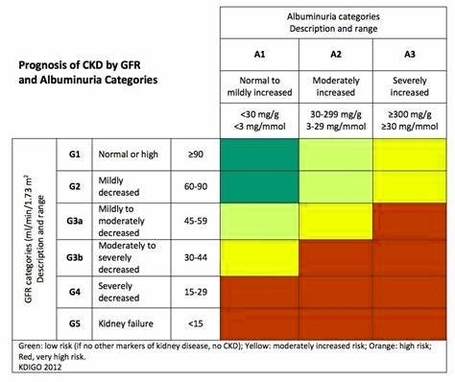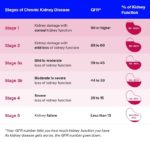Understanding the Chronic Kidney Disease (CKD) Heatmap
The CKD Heatmap is a crucial tool used in assessing the risk of kidney disease in individuals. It provides a comprehensive picture of an individual’s kidney health, guiding treatment based on the risk of CKD progression and heart disease.
Key Components of the CKD Heatmap
1. Kidney Numbers: The heatmap uses two key kidney numbers, the Estimated Glomerular Filtration Rate (eGFR) and the Urine Albumin to Creatinine Ratio (uACR).
– eGFR: This is a blood test that shows how well your kidneys filter (clean) your blood.
– uACR: This is a urine test that shows if your kidneys are leaking protein (albumin) into your urine, which may indicate kidney damage.
2. CKD Stages: On the left side of the heatmap, your eGFR number matches up with a CKD stage. A higher eGFR number is better because it means you have a lower CKD stage.
3. uACR Levels: On the top of the heatmap, your uACR number matches up with a uACR level. A lower uACR is better because that means less albumin in the urine.
4. Risk Colors: The heatmap is color-coded based on your risk for CKD getting worse, and your risk for heart disease.
– Green: You do not have CKD, or you are at the lowest risk for CKD getting worse.
– Yellow: You are at increased risk for CKD getting worse.
– Orange: You are at high risk for CKD getting worse.
– Red: You are at the highest risk for CKD getting worse.
Reading the CKD Heatmap
To read the CKD Heatmap, you draw a line down from your uACR level and another line across from your CKD stage. The intersection of these lines corresponds to a color that indicates your risk for CKD getting worse. For example, if your eGFR is 35 (CKD stage G3b), and your uACR is 350 (level A3), these lines meet at a red box, which means that youre at the highest risk for CKD getting worse.
Importance of the CKD Heatmap
The CKD Heatmap is a vital tool for early identification and intervention in kidney disease. It allows for a clear understanding of an individual’s kidney health, guiding treatment decisions and potentially preventing the progression of CKD. By knowing your kidney numbers and understanding the CKD Heatmap, you can take proactive steps to maintain your kidney health.


